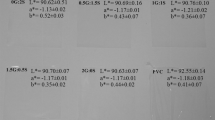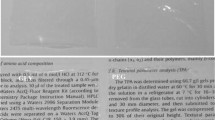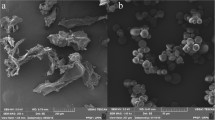Abstract
The effect of protein concentrations on the properties of fish myofibrillar protein film (FMP) were investigated and compared with commercial wrap film (polyvinyl chloride; PVC). FMP (2 %, w/v) showed the highest mechanical properties [tensile strength: 4.38 MPa and elongation at break: 133.05 %], and water vapor permeability [2.81 × 10−10 g m−1 s−1 Pa−1]. FMP contained high molecular weight cross-links, resulting in complex film network, as indicated by lower film solubility (19–22 %) and protein solubility (0.6–1.3 %). FMP showed excellent barrier properties to UV light at the wavelength of 200–280 nm. FMP had the thickness [0.007–0.032 mm], color attributes and transparency similar to PVC film [thickness: 0.010 mm]. Therefore, protein concentration majority influenced the properties of develop FMP. The protein content of 1 % (w/v) had potential to be developed the biodegradable film with comparable properties to the commercial wrap film.




Similar content being viewed by others
References
ASTM (1989) Standard test methods for water vapor transmission of materials. Standard designation E96–E80. Annual book of ASTM standard, Philadelphia pp 730–739
Barreto PLM, Pires ATN, Soldi V (2003) Thermal degradation of edible films based on milk proteins and gelatin in inert atmosphere. Polym Degrad Stab 79:147–152
Chang C, Nickerson MT (2015) Effect of protein and glycerol concentration on the mechanical, optical, and water vapor barrier properties of canola protein isolate-based edible films. Food Sci Technol Int 21:33–44
Chinabhark K, Benjakul S, Prodpran T (2007) Effect of pH on the properties of protein-based film from bigeye snapper (Priacanthus tayenus) surimi. Bioresour Technol 98:221–225
Cuq B, Aymard C, Cuq J-L, Guilbert S (1995) Edible packaging films based on fish myofibrillar proteins: formulation and functional properties. J Food Sci 60:1369–1374
Cuq B, Gontard N, Cuq JL, Guilbert S (1996) Rheological model for the mechanical properties of myofibrillar protein-based films. J Agric Food Chem 44:1116–1122
Cuq B, Gontard N, Cuq JL, Guilbert S (1998) Packaging films based on myofibrillar proteins: fabrication, properties and applications. Nahrung/Food 42:260–263
Garcı́a FT, Sobral PJA (2005) Effect of the thermal treatment of the filmogenic solution on the mechanical properties, color and opacity of films based on muscle proteins of two varieties of tilapia. LWT Food Sci Technol 38:289–296
Gennadios A (2002) Protein-based films and coatings. CRC Press, New York
Gennadios A, Handa A, Froning GW, Weller CL, Hanna MA (1998) Physical properties of egg white − dialdehyde starch films. J Agric Food Chem 46:1297–1302
Gounga ME, Xu S-Y, Wang Z (2007) Whey protein isolate-based edible films as affected by protein concentration, glycerol ratio and pullulan addition in film formation. J Food Eng 83:521–530
Hamaguchi PY, WuYin W, Tanaka M (2007) Effect of pH on the formation of edible films made from the muscle proteins of blue marlin (Makaira mazara). Food Chem 100:914–920
Han JH, Floros JD (1997) Casting antimicrobial packaging films and measuring their physical properties and antimicrobial activity. J Plast Film Sheet 13:287–298
Iwata KI, Ishizaki SH, Handa AK, Tanaka MU (2000) Preparation and characterization of edible films from fish water-soluble proteins. Fish Sci 66:372–378
Jongjareonrak A, Benjakul S, Visessanguan W, Prodpran T, Tanaka M (2006) Characterization of edible films from skin gelatin of brownstripe red snapper and bigeye snapper. Food Hydrocoll 20:492–501
Kaewprachu P, Rawdkuen S (2014) Mechanical and physico-chemical properties of biodegradable protein-based films: A comparative study pp. 14–29 In: The 2nd International Conference on Food and Applied Bioscience February 6–7, The Empress Hotel, Chiang Mai, Thailand. Food and Applied Bioscience Journal, Chiang Mai, Thailand
Kokoszka S, Debeaufort F, Hambleton A, Lenart A, Voilley A (2010) Protein and glycerol contents affect physico-chemical properties of soy protein isolate-based edible films. Innov Food Sci Emerg 11:503–510
Laemmli UK (1970) Cleavage of structural proteins during the assembly of the head of bacteriophage T4. Nature 227:680–685
Le T, Maki H, Takahashi K, Okazaki E, Osako K (2015) Properties of gelatin film from horse mackerel (Trachurus japonicus) scale. J Food Sci 80:E734–EE41
Li H, Liu BL, Gao LZ, Chen HL (2004) Studies on bullfrog skin collagen. Food Chem 84:65–69
Limpisophon K, Tanaka M, Weng W, Abe S, Osako K (2009) Characterization of gelatin films prepared from under-utilized blue shark (Prionace glauca) skin. Food Hydrocoll 23:1993–2000
McHugh TH, Avena-Bustillos R, Krochta JM (1993) Hydrophilic edible films: modified procedure for water vapor permeability and explanation of thickness effects. J Food Sci 58:899–903
Nur Hanani ZA, Roos YH, Kerry JP (2012) Use of beef, pork and fish gelatin sources in the manufacture of films and assessment of their composition and mechanical properties. Food Hydrocoll 29:144–151
Oujifard A, Benjakul S, Prodpran T, Seyfabadi J (2013) Properties of red tilapia (Oreochromis niloticus) protein based film as affected by cryoprotectants. Food Hydrocoll 32:245–251
Prodpran T, Benjakul S (2005) Effect of acid and alkaline solubilization on the properties of surimi based film. Songklanakarin J Sci Technol 27:563–574
Robinson HW, Hodgen CG (1940) The biuret reaction in the determination of serum proteins: I. a study of the conditions necessary for the production of a stable color which bears a quantitative relationship to the protein concentration. J Biol Chem 135:707–725
Rocha M, Loiko MR, Gautério GV, Tondo EC, Prentice C (2013) Influence of heating, protein and glycerol concentrations of film-forming solution on the film properties of argentine anchovy (Engraulis anchoita) protein isolate. J Food Eng 116:666–673
Shiku Y, Hamaguchi PY, Tanaka M (2003) Effect of pH on the preparation of edible films based on fish myofibrillar proteins. Fish Sci 69:1026–1032
Sobral PJA, Santos JS, García FT (2005) Effect of protein and plasticizer concentrations in film forming solutions on physical properties of edible films based on muscle proteins of a Thai tilapia. J Food Eng 70:93–100
Tanaka MIS, Suzuki T, Takai R (2001) Water vapor permeability of edible films prepared from fish water soluble proteins as affected by lipid type. J Tokyo Univ Fish 87:31–37
Wittaya T (2012) Protein-based edible films: characteristics and improvement of properties. IOP Publishing Intech. http://www.intechopen.com/books/structure-and-function-of-food-engineering/protein-based-edible-films-characteristics-and-improvement-of-properties. Accessed 1 March 2015
Zavareze ER, Halal SLME, Marques e Silva R, ARG D, Prentice-Hernández C (2014) Mechanical, barrier and morphological properties of biodegradable films based on muscle and waste proteins from the whitemouth croaker (Micropogonias furnieri). J Food Process Preserv 38:1973–1981
Acknowledgments
The author would like to thank Mae Fah Luang University and the Thailand Research Fund for the financial support through the Royal Golden Jubilee Ph.D. Program (Grant NO. PHD/0029/2555) to Ms. Pimonpan Kaewprachu.
Author information
Authors and Affiliations
Corresponding author
Ethics declarations
Competing interests
There are non-financial competing interests (political, personal, religious, ideological, academic, intellectual, commercial or any other) in relation to this manuscript to declare.
Rights and permissions
About this article
Cite this article
Kaewprachu, P., Osako, K., Benjakul, S. et al. Effect of protein concentrations on the properties of fish myofibrillar protein based film compared with PVC film. J Food Sci Technol 53, 2083–2091 (2016). https://doi.org/10.1007/s13197-016-2170-7
Revised:
Accepted:
Published:
Issue Date:
DOI: https://doi.org/10.1007/s13197-016-2170-7




